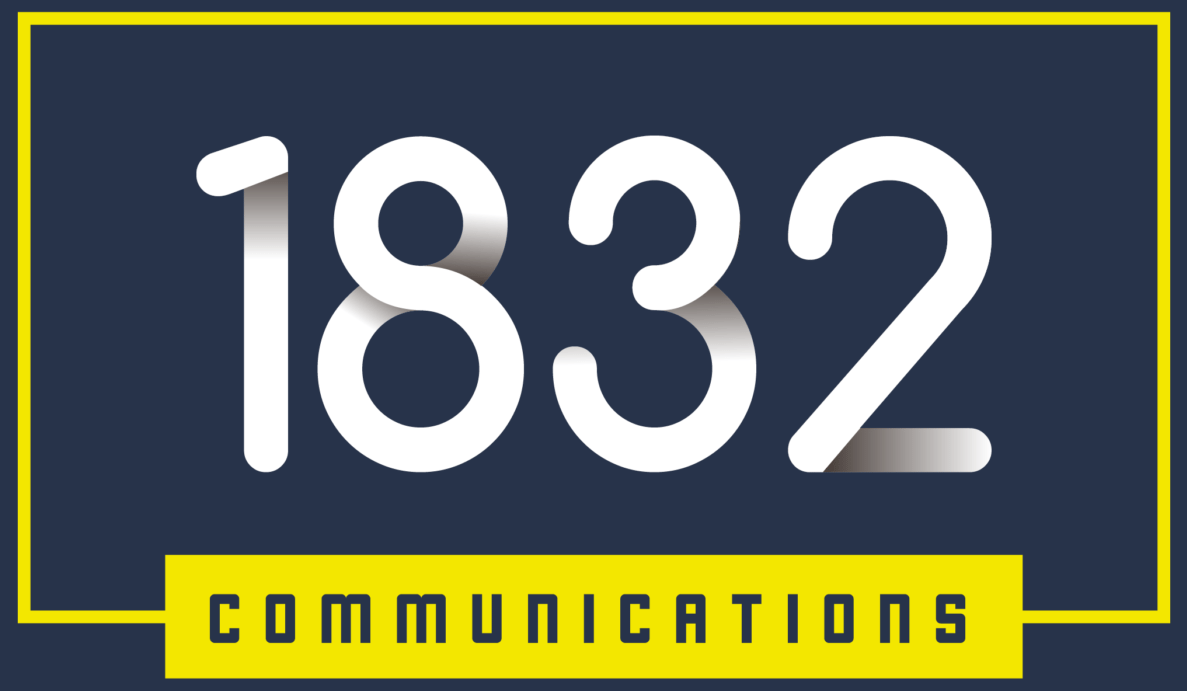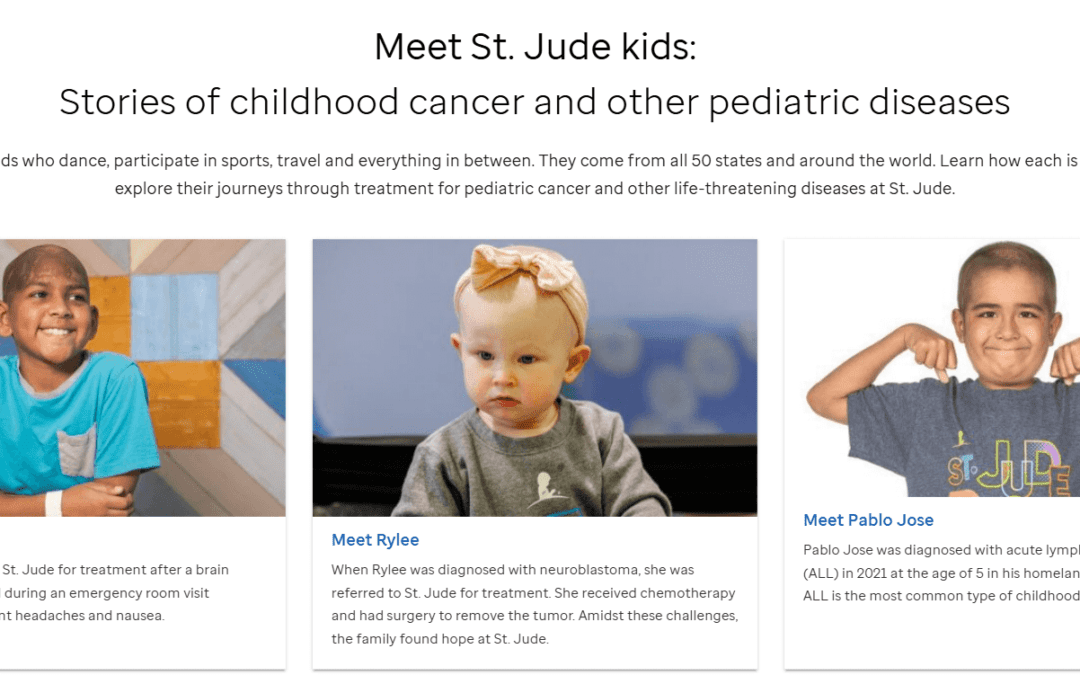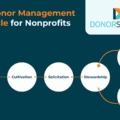This is a guest post by Ann Fellman
Storytelling is a compelling way to drive support for your nonprofit’s mission. Stories are memorable and are one of the primary ways people communicate, making up about 65% of our conversations.
No matter whether someone has just heard about your nonprofit for the first time or is deciding to become a recurring donor, stories capture their imagination and inspire them to get involved.
Let’s look at storytelling strategies to use at every stage of the donor journey. Bloomerang defines the donor journey as these four steps:
- Awareness
- Research
- Decision
- Retention
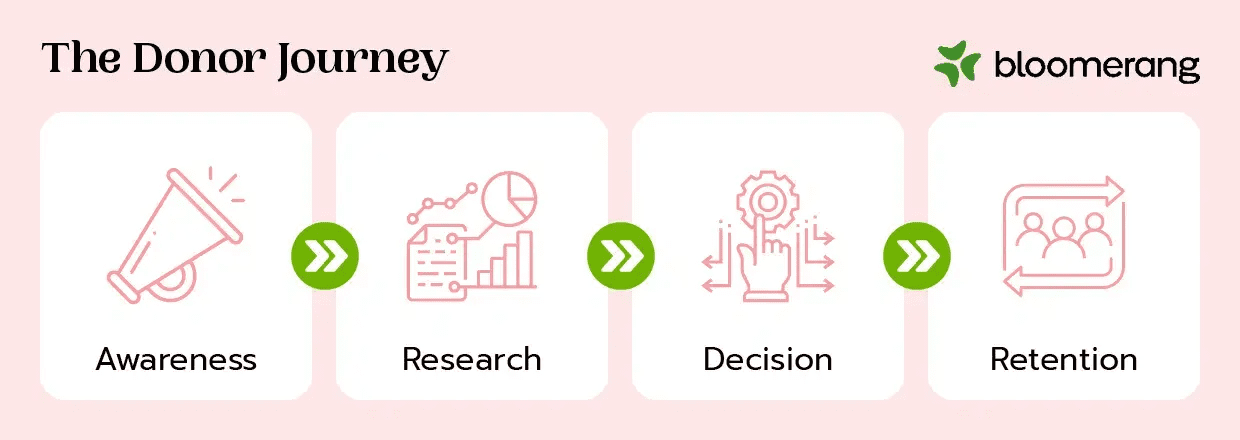
Each step offers unique opportunities to connect with audience members and facilitate deeper relationships.
Awareness
In the awareness phase, prospective new donors hear about your nonprofit for the first time. In this step, your organization’s job is to capture their attention with compelling and eye-catching stories that spark their interest and inspire them to learn more about your cause.
Where to tell stories at this stage
-
- Google Ads. Google Ads are paid text ads that appear at the top of search engine results pages. You can create ads for search queries relevant to your mission. For example, if you’re a conservation organization, create targeted ads for keywords like “nonprofit conservation donations.” Remember that your nonprofit may be eligible for the Google Ad Grants program, which provides $10,000 monthly in free Google advertising.
- Social media promotion. Both organic and paid social media posts can help introduce your mission to a broader online audience. Use text, photos and videos to paint a robust and authentic picture of your mission.
- Event registration pages. Events are a great way to capture the attention of casual online audience members. People searching for events related to your cause may come across your organization’s event registration pages and resonate with your mission. For example, you could inspire local runners to join your annual 5K event or nearby businesses to join peer-to-peer fundraisers to support their corporate social responsibility goals.
Tips for meeting donors’ needs at this step
- Introduce audience members to your mission. Include all the background information new supporters need to know about your nonprofit’s mission and vision for the future. Contextualize your organization by describing how you build up your community through food support, building houses, offering educational workshops, etc.
- Appeal to emotions. Use powerful words like “Join the Fight!” and “Be the Change in Your Community” to inspire new supporters to learn more about your cause. Additionally, leverage photos and videos depicting your beneficiaries, volunteers and other stakeholders to help form an emotional connection with your new online audience members.
Example
Based on the example above, here’s a look at the Google Ads that appear for the keyword “nonprofit conservation donations”:
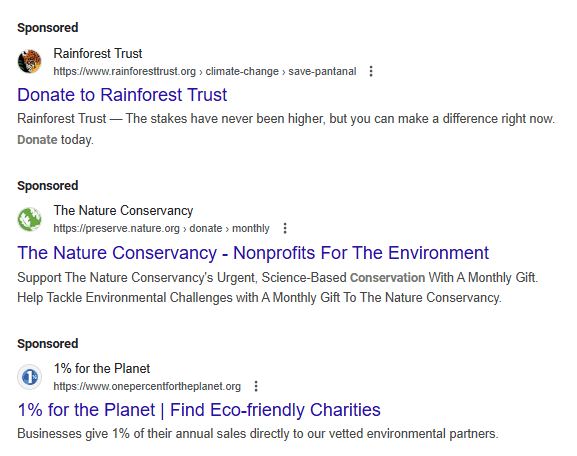
These ads introduce new supporters to each organization’s mission by describing what the nonprofit does and how easy it is to get involved and make a significant impact.
However, as you can see, these ads don’t offer much space for telling stories. With that in mind, you can experiment with creative ways to incorporate stories, even with limited space in Google or social media ads. For example, you could introduce a beneficiary and continue their story by linking to a testimonial or your online donation page in the ad.
Research
The next step of the donor journey is when new audience members research your organization more deeply to understand its financial situation, goals, past successes, challenges and other key details. At this stage, your storytelling efforts should focus on providing educational content to prospects that makes it easier to understand what you’re all about.
Where to tell stories at this stage
- Email marketing newsletters. Use website call-to-action (CTA) buttons to encourage visitors to register for your email newsletter. Include stories in your newsletter recapping recent events, describing specific wins your nonprofit achieved through generous donations and highlighting beneficiary stories about their connection to your cause.
- Website About page. Introduce new supporters to your organization’s staff using a robust About page. Incorporate stories about the history of your founding and the backgrounds of your leadership, board members and staff.
- Case studies and testimonials. Illustrate your organization’s impact by sharing beneficiary testimonials and case studies describing your successful projects or programs. Include direct quotes from beneficiaries to make your testimonials feel more personal. In addition, incorporate data points into your case studies to back up your narrative with hard facts and enhance your credibility.
- Annual reports. Create a landing page on your website to house all recent annual reports. Use a combination of statistics and stories in your annual reports to highlight your accomplishments and challenges from each year. Also, include detailed financial information so prospective donors can understand your financial viability.
Tips for meeting donors’ needs at this step
- Be transparent. Explain your organization’s wins and obstacles. Prospective supporters will respect your commitment to transparency and honesty.
- Introduce audiences to the real people involved in your mission. Show audience members that your organization is backed by passionate and credible people who believe in your mission. Highlight stories from staff, volunteers, beneficiaries, board members and subject matter experts with expertise in your field.
Example
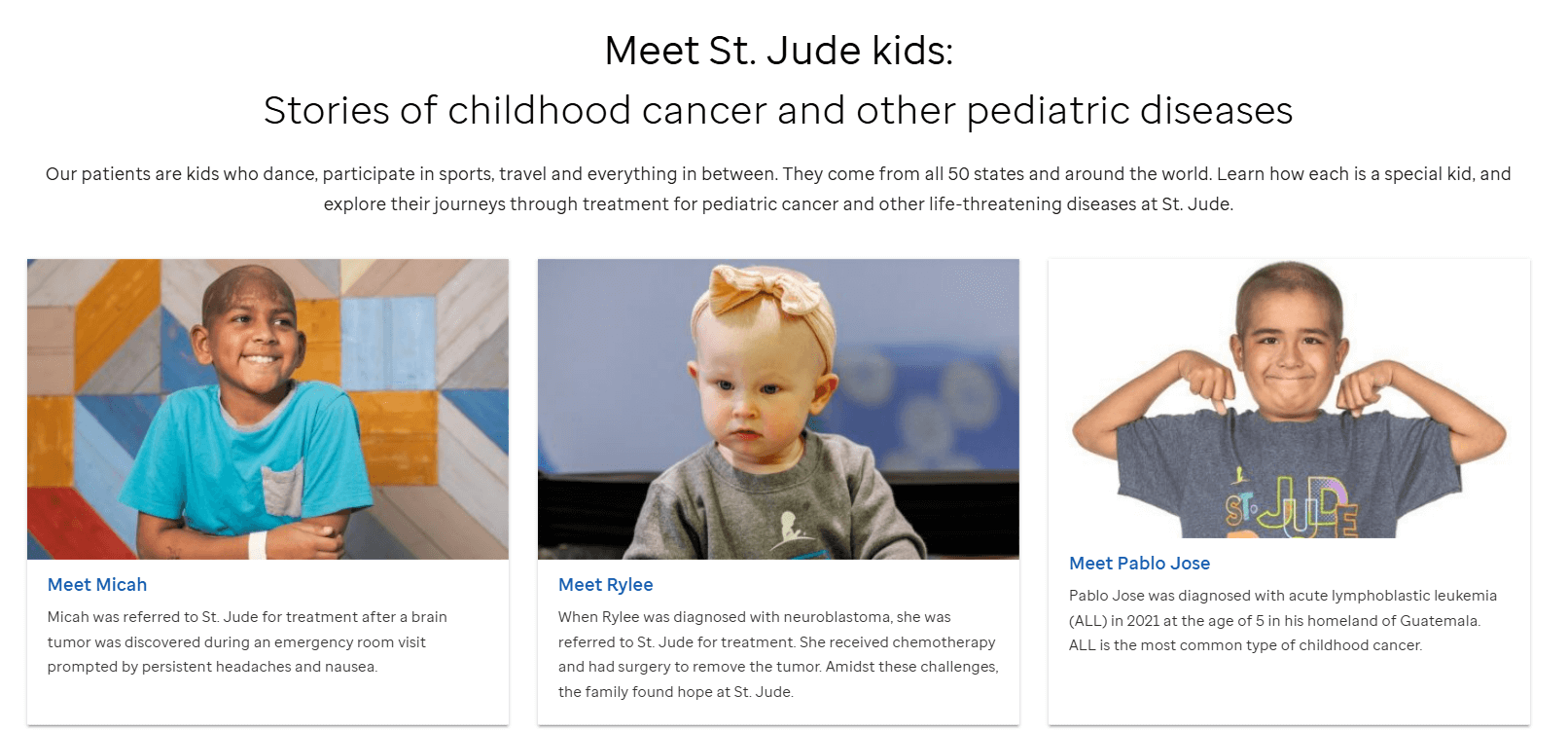
St. Jude Children’s Research Hospital offers a robust Patient Stories web page featuring emotional and inspiring stories about the children supported by the organization’s childhood cancer and pediatric disease research and treatments. Readers can see photos of the children and direct quotes from kids and their families, helping them form an emotional bond with the organization’s mission.
Decision
In the decision phase, new audience members decide whether to give to your nonprofit. This is a delicate step of the donor journey because many prospects fall out of the giving funnel before ever contributing. Your organization must offer a simple giving process and a compelling pitch to inspire more audience members to become true supporters.
Where to tell stories at this stage
- Calls to action. Use CTA buttons throughout your website and a donation page link in your top-level menu to direct visitors to your online giving form. Make your CTAs stand out using powerful words and bright, contrasting colors.
- Text-to-give and email messages. If you’ve gathered prospects’ phone numbers and email addresses, use them to reach out with direct donation appeals. Leverage your text-to-give platform and email tool to send appeals such as “Fight back against deforestation in your community. Complete your donation with our online giving form.” Incorporate stories into these appeals to urge prospects to give, with photos of the beneficiaries involved.
- Online donation page description. Make a final motivational appeal via your online giving form’s description. Remind potential donors of what their gift will support and include specific impact information, such as “A $100 donation will fund supplies and food for five new shelter dogs.”
Tips for meeting donors’ needs at this step
- Simplify the giving process. Ensure your online donation page is simple and quick to complete, with minimal questions. Just ask for donors’ names, payment details, donation amounts and contact information.
- Provide multiple ways to give. Appeal to a wide range of donor needs by offering numerous ways to donate, including various credit/debit cards, digital wallets like Venmo and Paypal and ACH payments.
- Use donor-centric language. Keep the focus on your donors’ impact rather than your organization. For example, your donation page should say something like “Your Gift Can Change Someone’s Life” rather than “Our Work Changes Lives.” This messaging empowers donors and reminds them that their gifts have a tangible impact on your cause.
Example
The CARE online donation page features a gripping donation appeal at the top, with information about the challenges the organization helps solve and the impact of specific donation amounts. The form also includes clear and convincing details about how the organization allocates funding and the scope of their positive impact, reassuring donors that their gifts will go to a credible and influential organization.

Retention
The final phase of the donor journey involves turning one-time donors into recurring, dedicated supporters of your mission. The retention step relies on ongoing storytelling and appreciation efforts that demonstrate donors’ impact and the benefits of becoming long-term supporters.
Where to tell stories at this stage
- Appreciation emails and letters. Your donor appreciation letters allow you to build long-term relationships with new supporters. Include a heartfelt message of gratitude and impact stories about what donors’ gifts will help achieve. Open the door to further engagement by providing additional ways to stay in touch with your organization, including your social media pages and email newsletter.
- Thank-you phone calls. A brief phone call can also be an effective way to share impact information with donors and express your gratitude in a more personal way. Provide your donor stewardship team with talking points or a short story to share in the phone calls, but encourage them to speak naturally and conversationally to create an authentic connection.
Tips for meeting donors’ needs at this step
- Personalize your outreach to show genuine appreciation. Address your thank-you emails and letters with donors’ preferred names. Mention their specific donation amount to show them you’re paying attention to their efforts.
- Send appropriate follow-up messages. Send donors relevant thank-you and follow-up messages based on their type of gift. For example, you could send small or mid-level donors information about submitting matching gift requests to their employers or details about joining your next peer-to-peer fundraising campaign. For major donors, avoid sending another follow-up donation request too quickly. Instead, keep your messages focused on spotlighting the ongoing impact of their monumental gifts.
- Create a donor community. Invite donors to become members of exclusive clubs, such as your monthly giving program or major donor giving society. Describe the perks of these groups, such as access to exclusive events and newsletters or opportunities to meet with your organization’s top leaders. You could even gamify donors’ involvement by offering certificates or points for donors who complete certain activities, like joining events or successfully completing peer-to-peer fundraising campaigns.
Example
Bloomerang offers the following sample donation appreciation email that your organization can use for inspiration when crafting your own gratitude messages:
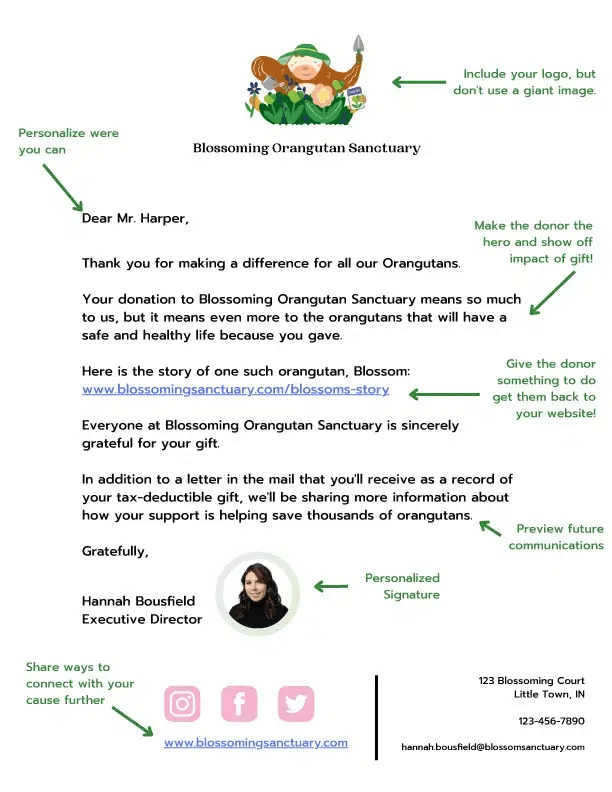
The template includes key best practices, such as a personalized greeting, donor-centric language, impact information, and additional ways to stay connected with the organization.
These storytelling strategies and tips are geared toward meeting donors where they are and growing authentic relationships with them. Track metrics such as your new donor acquisition rate, donor retention rate, and email and social media engagement to understand the effectiveness of your communication efforts. You can also send donor feedback surveys with questions about your storytelling efforts to ensure you meet donors’ needs at every stage.

As the Chief Marketing Officer at Bloomerang, Ann is responsible for the company’s overall thought leadership, brand, marketing, and community outreach programs that work to strengthen relationships with customers and the broader nonprofit community. Ann brings over 24 years of experience in business-to-business (B2B) marketing in the technology industry, including time spent working at a nonprofit organization.
